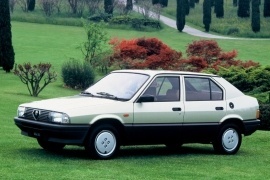
ALFA ROMEO 33
Generations Timeline, Specs and Pictures

Introduced in the early ’80s - 1983 - the Alfa 33 was aimed to become a true successor of the famous Alfasud model.
Despite suffering from reliability problems throughout the ’80s, this new family car hung in there and was sold in no less than a million units throughout its 9 years of existence. Its second - and most consistent - facelift featured major changes in terms of interior & exterior design, while also introducing the 33 model to a new fuel injection system. It basically prepared the main public for the launch of the new 164 model, as the two cars had many design lines in common.

Alfa Romeo tried to do something different than most competitors on the market and introduced a crossover version for the 33 range, long before the term entered into the automotive dictionary.
The Italian brand was new on the all-wheel-drive systems, but it still tried to offer a vehicle that could cope well with snowy roads and other slippery surfaces. Since most 4x4 vehicles sported a higher ground clearance, the carmaker added a lift kit to make the car more capable on unpaved roads.
The Italian carmaker worked with Pininfarina to develop the Giardinetta (Station Wagon) version of the Alfa 33. It was 13 cm (5.1”) longer than its hatchback brother and featured an extended roof over the trunk area. It was still wedged-shaped, but that was right for those times. The carmaker added the third set of windows covering side areas between the rear doors and the raked-forward D-pillars. A set of black plastic moldings protected the lower side of the bodywork from stone chips, bushes, and the usual shopping carts.
Inside, the car was similar to the regular Alfa 33. It sported a three-spoke steering wheel and a narrow, flat-designed dashboard. There was room for two adults at the front, separated by a small transmission tunnel between them. On the other hand, that tunnel prevented the car from accommodating three passengers in the back comfortably.
Under the hood, Alfa Romeo installed a 1.5-liter engine paired to an all-wheel-drive system with a Torsen center differential. But the engine was too small and the car too heavy for it. That led to big fuel consumption. Later on, Alfa Romeo dropped the Giardinetta with its all-wheel-drive system.

The 1983 Alfa Romeo 33 was produced in over one million units between 1983 and 1994.
It replaced the Alfasud and it was renowned for its nimble handling.
Alfa Romeo had to move forward and increase its sales. To do that, they had to change the rear-wheel-drive platforms to front-wheel-drive so the cars would handle better and be easier to drive. Despite the Alfa Romeo fans, the evolution had to be done. After the Alfasud, Alfa 33 was a very important car for the Italian brand. It was nimble, affordable, and easy to drive. It was offered as a hatchback, station-wagon, and even in 4x4 configuration with higher ground clearance. Something that, years later, would have been named a crossover. It was ahead of its time.
At the beginning of the ’80s, the customers were looking for cars with sharper edges. It was the idea that a boxier looking car would be safer to drive. That trend was followed by most of the car manufacturers in Europe. So it was the Alfa 33, with its sharp, straight lines, square headlights and trapezoidal taillights. The two-and-a-half body style was appealing for Italian customers.
Inside, the Alfa 33 featured an innovative dashboard, with a center console designed as a separate unit from the instrument cluster. The binocular-style dials were something new on a market that offered only a panel with gauges on it. Due to its platform, the interior room was good enough for five adult passengers. The rear seats backseat could have been folded and increase the, otherwise small, trunk.
The Alfa 33 featured boxer engines, helping to lower the center of gravity and improve handling. With the introduction of the 4x4 on demand and, later on, permanent all-wheel-drive system, the car handled well even on unpaved roads.























































